|
INDENTATION TO PROBE PHYSIOLOGY AND PATHOLOGY OF THE MAMMALIAN LUNG: 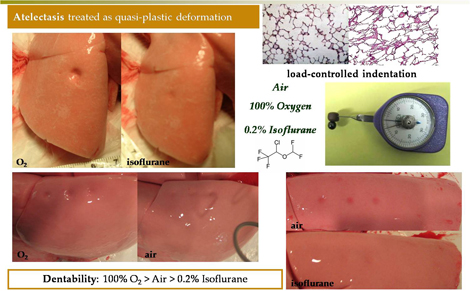
Microscopic indentation of lungs using different inflation gases reveals significantly different plastic behavior depending on gas composition.
Intrinsic tissue properties provide some mechanical influence, but behavior is dominated by surfactant on many levels. Mechanics of lung in inflation has been studied in numerous clinical and laboratory studies, but under shear or high-strains, limited studies have been performed, due to the difficulty in mechanical testing on lung. In this talk I will describe indentation experiments on lung, and how quasi-plastic behavior can be correlated to atelectasis, or alveolar collapse. Atelectasis is a highly important consideration in anesthesia and critical care, but hard to study due to its random occurrence. Our systematic studies have shown that this pathology can be highly sensitive to inflation gas, suggesting a possible alteration of lung surfactant properties. 
Sub-surface imaging provides direct evidence of atelectasis under compressive loading, and gives insight into its location and distribution.
Mechanisms and criteria of atelectasis remain unclear, largely due to the inability to image or preserve deformed lung. Here, I will discuss how we have addressed this need, with in-situ images of sub-surface lung deformation using Optical Coherence Tomography (OCT). Rat lungs were inflated to various physiologic pressures, and indented using both spherical and cylindrical ("rib-like") indenters, and atelectasis observed in-situ. In addition, deformation patterns were compared to FEM models that incorporated lung parenchyma and surface pleural membrane. By comparing the models and experiments, we are able to draw robust conclusions concerning the mechanical criteria for atelectasis, namely the effects of hydrostatic pressure or shear, on alveolar collapse. Results and questions arising from this work have direct relevance to anesthesia and critical care methods and practices. FABRICATION OF NANOPOROUS METALLIC SURFACES VIA RAPID IMPACT AND SOLIDIFICATION OF MOLTEN DROPLETS: The figure shows a schematic of the TS process, in which molten droplets are impacted and rapidly solidified on a substrate to be coated. Each particle forms a 'splat', the shape of which is determined by process parameters (velocity, viscosity) and surface characteristics (wetting, etc). 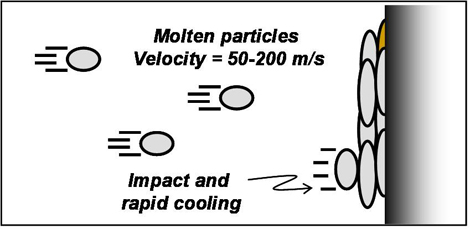
During TS, molten particles are propelled toward a substrate at roughly 100-200 m/s, where they impact, flatten and rapidly solidify.
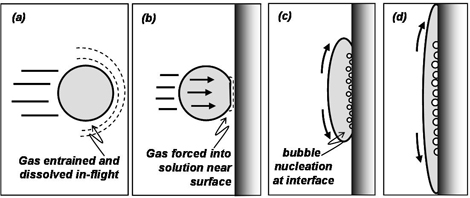
Cartoon displaying proposed mechanism of nanobubble formation in impacting splats.
Recently we observed a nanoporous architecture on the underside of Ni splats. We attributed this to the impact and rapid depressurization of the liquid droplet, causing dissolution, supersaturation and finally nucleation of entrained gas into bubbles. Bubbles are frozen into pores upon solidification. 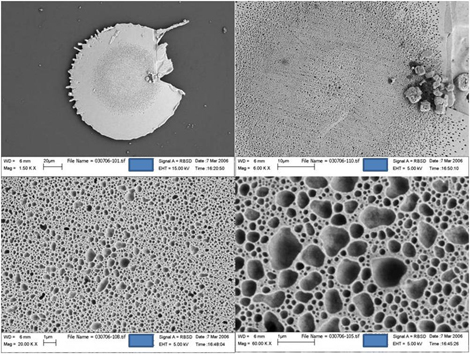
SEM images of the underside of an Ni splat, showing the nonoporous structure arising from the nucleation and freezing of tiny bubbles upon impact.
Quantitiative support for this theory was found in the volcanics literature. That is to say, using our process parameters as input, known nucleation models predicted our observations closely. This work was recently published in Applied Physics Letters. We have empirically explored different substrates, treatments and process parameters and their effects on bubble nucleation and pore formation. In addition to the fundamentals, we have shown through experiments and preliminary modeling that this bubble formation may have a critical effect on TS coating adhesion, and the true role of surface roughening in substrate preparation. 
Left to right are three stainless steel substrates, with roughness of 1.3 microns, 0.6 microns and mirror polish. Bottom half shows distribution of splats as-sprayed, and top half shows remaining splats after tape pull-off. It is apparent that splats stick far more effectively on rough surface.
A substrate of typical grit-blasted roughness would alter the dynamics of splat impact, greatly reducing the initial hydrostatic pressure. This would decrease nucleation rate and porosity, the end result being better adherence of splats. We tested this, by pulling off splats from different roughness substrates, and assessing adhesion via statistical methods. Results are shown here, and suggest the hypothesis is correct. MECHANICS (PARTICULARLY LOW-STRAIN FATIGUE) OF THERMAL SPRAYED COATINGS: Despite the above complexities, the TS research community and industry have made large steps forward in process control, mechanical/functional characterization and lifetime measurement, particularly in the last two decades. Scientific method is being incorporated into design, new materials choices are being implemented, and advanced characterization and modeling is being applied to defect structure. 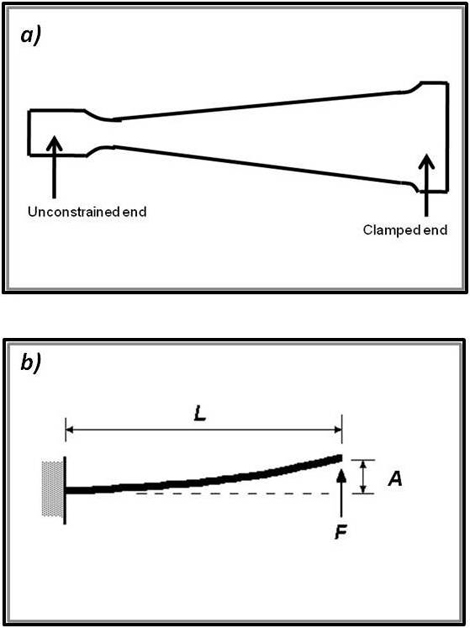
Constant strain cantilever used for cyclic loading of coated substrates.
However, when it comes to mechanical property characterization, the TS community is still very much following a 'take what we can get' philosophy; specifically in mechanical properties, coatings are defined by an elastic modulus and hardness, and perhaps wear characterization, often with little regard for measurement artifact that results. Absolute values, suitable for models, etc, are not obtained, but trends are used to compare results of different processes. This has proven suitable for quality control of coatings in passive applications, but as the TS industry eyes more prime-reliant or 'high-tech' uses, such as electronic materials, or biocompatible coatings, our knowledge of them must also necessarily improve. In addition, as the scientific understanding of TS becomes more quantitative and rigorous, it could serve to initiate a strong technological pull from potential industrial end-users. 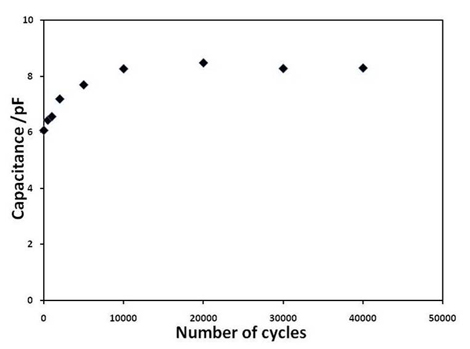
Under nominally elastic strains, an APS Spinel coating displays a permnent change in crack distribution, as measured via Capacitance.
Coating fatigue is neither well-characterized nor well-understood. Lifetime tests are carried out on hardface coatings for landing gear, and high-strain cyclic tests are performed to induce coating de-bonding. When investigating fracture toughness or fatigue with regard to cohesive failure, artificial cracks are initiated using notches, as for bulk materials. In addition, under purely mechanical loads in service, TS coatings are assumed not to change. That is to say, there is an implicitly agreed 'endurance limit, well-within the service range of coatings, below which TS materials are assumed not to fatigue, nor alter their microstructure. We have performed experiments on metallic and ceramic TS coatings on substrates that suggest this is NOT the case, and that irreversible changes in microstructure or defect architecture occur during cycling within nominally elastic strains (< 0.05%), within 102 cycles. Our lab is systematically exploring this using experiments and analytical/computational modeling. |